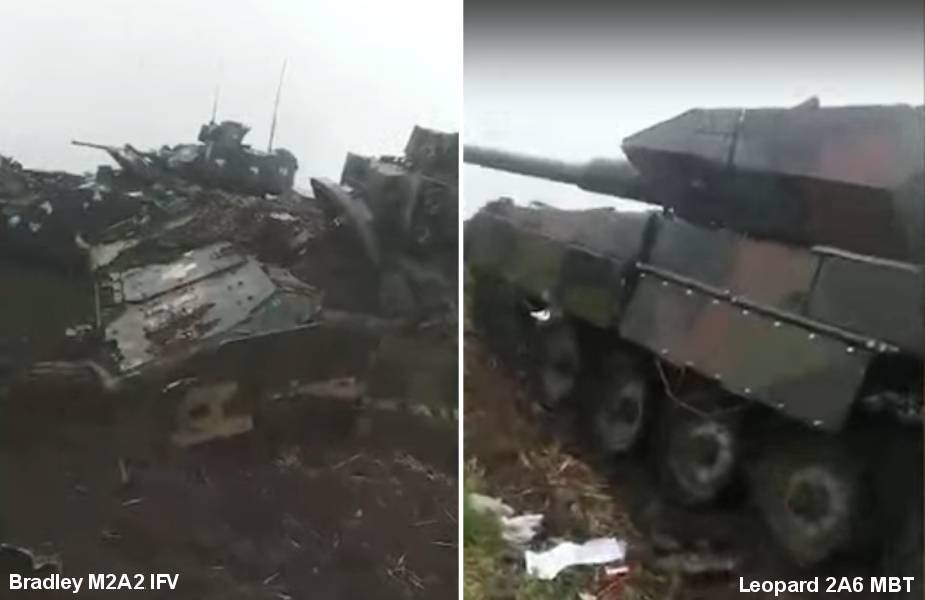- Army
- Conflicts in the world
- Israel - Iran conflict 2025
- Pakistan - India Conflict 2025
- Russia Ukraine War 2022
- Libya conflict day by day
- HAMAS - Israel War 2023
- Operation Serval in Mali French Army
- Sangaris operation Central African Republic
- Sangaris opération militaire République Centreafrique
- Ukraine - Russia conflict
- Syria conflict news
- Defence & Security Industry Technology
- Armies in the world
- Analysis Defense and Security Industry
- Conflicts in the world
- Navy
- Air
Russian soldiers attempt to recover recently damaged Ukrainian Leopard 2A6 tank and Bradley M2A2 IFVs
In the latest development of the war in Ukraine, the Russian Ministry of Defense released a video on June 12, 2023, revealing their attempts to recover and later analyze the technology of damaged Western military vehicles in service with the Ukrainian army, specifically, the German Leopard 2A6 tank and the American Bradley M2A2 IFVs (Infantry Fighting Vehicles). The captured footage comes in the wake of Russian artillery attacks against these Ukrainian vehicles on June 11, 2023.
Follow Army Recognition on Google News at this link

Russian soldiers try to recover damaged Ukrainian Leopard 2A6 tank and Bradley M2A2 IFVs following a recent artillery attack. (Picture source: video footage screenshot from Russian MoD)
The Ukrainian armed forces have received Leopard 2A6 tanks, a German-made advanced main battle tank, and M2A2 Bradleys, an American-produced IFV. These vehicles represent some of the latest advancements in Western military technology. The Russian recovery effort is reportedly aimed at gaining insights into these cutting-edge technologies. Hence a major question: why didn't the Ukrainians try to blow up at least the turret of their Leopard 2A6 tank and M2A2 Bradleys by dropping grenades before escaping? It would have at least damaged the most interesting sophisticated devices of these vehicles.
As per the released video, Russian soldiers are seen making recovery attempts of the damaged armored vehicles. The Russians will certainly be seeking to dissect and analyze these technologically advanced war machines, potentially to advance their own defense technology or to develop countermeasures.
The recovery and potential analysis of the Leopard 2A6 tank, one of the most sophisticated main battle tanks currently in service with the Ukrainian forces, could provide Russia with a range of strategic advantages in the context of the ongoing conflict in Ukraine.
Primarily, the Leopard 2A6 is a shining example of Western armored vehicle technology. By recovering and dissecting this vehicle, Russia stands to gain valuable insights into the methods and design principles employed by Western countries in their tank development. This understanding could help them to improve their own technology, or develop effective countermeasures against similar vehicles in future engagements.
Moreover, the recovery process itself, if successful, could provide a psychological boost for Russian forces. The act of repurposing an enemy's advanced weapon for one's own use can be a significant propaganda victory. Publicizing this process, as seen in the video released by the Russian Ministry of Defense, can also serve as a potent demonstration of Russia's military prowess.
On a broader scale, if Russia can successfully reverse engineer or even replicate elements of the Leopard 2A6 technology, it may trigger a shift in the global balance of military power. By proving that it can match or potentially exceed Western technology, Russia may force other nations to reconsider their defense strategies and potentially spark a new arms race. On the other hand, Russia's T-14 Armata cutting-edge tanks remain "interestingly" absent from the battlefield, in spite of their widely mediatized shipment to Ukraine...
Finally, the knowledge gleaned from the Leopard 2A6 could also lead to the development of new tactics and strategies. By understanding the strengths and weaknesses of this vehicle, Russian forces could optimize their battlefield strategies not just for the current conflict, but for future engagements as well. In the end, the potential benefits for Russia are manifold, spanning from immediate tactical advantages to long-term geopolitical implications.


























